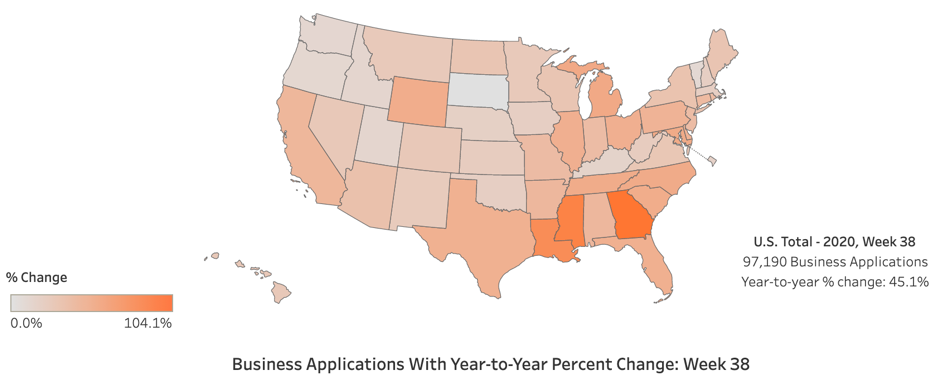What is the American Dream in 2020 … if there is one?
Plus, startups are at the highest rate in 13 years, watch the rising international COVID-19 numbers, gaming has grown during the pandemic, and more.
 Covering COVID-19 is a daily Poynter briefing of story ideas about the coronavirus and other timely topics for journalists, written by senior faculty Al Tompkins. Sign up here to have it delivered to your inbox every weekday morning.
Covering COVID-19 is a daily Poynter briefing of story ideas about the coronavirus and other timely topics for journalists, written by senior faculty Al Tompkins. Sign up here to have it delivered to your inbox every weekday morning.
As the presidential candidates debate tonight, you may be watching through the filter of who most closely matches your idea of what the American Dream looks like today.
This essay by Governing Magazine senior editor Alan Ehrenhalt gives us something to consider — and maybe even report about — between now and Election Day. He writes:
The phrase “American Dream” was first used in 1931 by the historian James Truslow Adams in his book The Epic of America. It meant, he wrote, “that dream of a land in which life should be better and richer and fuller for everyone.” Better and richer and fuller in what way? He didn’t say. Maybe in the middle of the Depression it seemed obvious. It doesn’t seem quite so obvious now.
What’s clearly true is that the American Dream has meant vastly different things to people in different times and places — if it has any sort of genuine meaning at all.
As a boomer, my understanding of the American Dream had something to do with owning a home with clean drinking water and maybe even air conditioning and being more financially secure than my parents were in rural Kentucky.
Photojournalist Ian Brown traveled 80,000 miles in a pickup truck to visit all 50 states over 12 years and documented that our dreams are as varied as we are. Some people dream grand dreams, others dare to dream to live to adulthood and be spared from the violence around them.
There is some data on this issue. Gallup regularly asks about that dream and whether it is attainable. Women generally see such a “dream” as unattainable, while men say it is.
YouGov heard from 14,000 people in their poll that asked about whether people believe in the American Dream, which it defined this way:
The American Dream is the belief that anyone, regardless of where they were born or what class they were born into, can attain their own version of success in a society where upward mobility is possible for everyone. The American Dream is generally thought to be achieved through sacrifice, risk-taking, and hard work, rather than by chance.
YouGov’s polling this year still showed a majority of the 14,000 people who participated said it is possible to attain the “American Dream.” Young Americans and Black Americans are far less likely to think such a dream is attainable. One in six Black Americans say they don’t believe there is such a dream.
Perhaps another version of the American Dream is to own your own business. Even in a pandemic, and even as thousands, maybe even hundreds of thousands of businesses will not survive over the next year, the Census Bureau says there have been 3.2 million requests for employer identification numbers, which is what a business needs to get started. Compare that to 2.7 million in the same period in 2019.

(From Census.gov)
And you will notice from this map that some of the states that had the highest COVID-19 rates also have the biggest growth in new business applications. You can get individual state data here.
Spain, France, the United Kingdom, Israel, Germany and several South American countries are all seeing an increase in COVID-19 cases, a trend that foretells what the U.S. may see soon. France just imposed new restrictions in 12 cities including Paris. The bans include big wedding gatherings and festivals, and museums have strict limits on crowd size. Some medical groups are pressing for “drastic measures” to avoid a second wave.

People shop near a Super Mario figure on display at Nintendo’s official store in the Shibuya district of Tokyo. (AP Photo/Jae C. Hong)
If there is a growth industry during this pandemic, besides toilet paper and hand sanitizer, it is the gaming industry. Just as an example, Axios points out:
Nintendo reported a whopping 428% increase in profits last quarter, driven largely by monster sales of its Nintendo Switch hardware product and its hit game “Animal Crossing.” The Japanese company made $1.37 billion in profit for the second quarter, smashing analyst estimates.
Electronic Arts and others also reported great earnings reports this summer.
NBCLX produced a story about how games like “Animal Crossing,” which unfolds over weeks and even months of play, is perfect for a pandemic. It not only helps players pass time but connects players with others.
The NPD Group, which monitors marketing, says the increase in gaming runs across all platforms. Its research (involving a survey of 5,000 gamers) shows at least a third of all game players are playing more than they did before the pandemic. And, mostly, they are still using the same devices that they did before the COVID-19 outbreak.
Three out of every four, or 244 million, people in the U.S. play video games, an increase of 32 million people since 2018; and multi-device usage has increased, with 65% of gamers using more than one device vs. 59% in 2018, according to 2020 Gamer Segmentation Report, the most recent study from The NPD Group.
According to the report, gamers average 14 hours per week playing video games, up from the 12 hours per week in 2018, when NPD issued its last gamer segmentation report. Thirty-nine percent of U.S. gamers are Light Players who play less than five hours per week, a decline of 8% from 2018. Moderate Players, gamers who play between five and 15 hours per week, make up 32% of the gaming community in the U.S., a 2% increase over 2018. Heavy Players play more than 15 hours per week and make up 29% of U.S. gamers, a 6% increase over 2018.
Nielsen research pegs the increase in gaming even higher and the demand seems to be strong enough to sustain even as pro sports and college sports are coming back to life.
Twitter is trying to encourage people to read before retweeting. How’s that for a new concept. I often find that I will post some big thumbsucker of a story and within seconds it is being retweeted or bashed when it is not possible for anybody to have read it that fast.
Twitter tested out a prompt that asked people if they read the story and found that prompt encouraged a 40% increase in people reading before tweeting.
Mashable explains what’s next with this experiment to fight fake news on Twitter.
Seniors who are infected by COVID-19 get most of our attention, but new Centers for Disease Control and Prevention data says, this summer, young people made up the single biggest age group of COVID-infected Americans.
Early in the pandemic, COVID-19 incidence was highest among older adults. But then the demographics shifted. The CDC says:
During June–August 2020, COVID-19 incidence was highest in persons aged 20–29 years, who accounted for more than 20% of all confirmed cases. Younger adults likely contribute to community transmission of COVID-19.
The study found that as the COVID-19 cases among young people increased, especially in Southern states, they likely spread the virus to older people. The same localities that saw an increase in coronavirus cases in younger populations measured an increase of cases in people over age 60 a week or two later. The young people seemed to be the source.
The CDC says this does not necessarily point out to reckless youthful behavior. Younger people may work at jobs that expose them to more vulnerability such as restaurants, bars, grocery stores and delivery services. And, the CDC says, it is also probably true that younger people are more likely to be less careful to keep socially distanced. Younger people are also less likely to show symptoms so they may unknowingly be spreading the virus.
A study by the Annenberg Public Policy Center found that COVID-19 conspiracy theories have found significant audiences. The just-published study found that conspiracy rumors are so widely believed that they get in the way of controlling the coronavirus. The study found:
More than 1 in 4 people (28%) in March reported believing that the Chinese government created the coronavirus as a bioweapon, a proportion that increased to 37% in July.
Nearly 1 in 4 (24%) believed in March that some in the U.S. Centers for Disease Control and Prevention, or CDC, are exaggerating the danger posed by the virus in order to damage Donald Trump’s presidency, which increased to 32% in July.
Nearly 1 in 7 (15%) believed that the pharma industry created the virus to increase sales of drugs and vaccines, which edged up to 17% in July.
In July, among those who were most likely to believe in the COVID-19 conspiracies, 62% reported wearing a mask every day that they went outside of the home and had exposure to others — compared with 95% of those who did not believe in the conspiracies. In other words, those who did not believe in the conspiracies were 1.5 times more likely to wear a mask every day outside of the home when they were in contact with others than the people who most strongly believed in the conspiracies.
Poynter’s PolitiFact team is constantly fact-checking COVID-19 claims. We have all of those fact checks in one place.
Fact-checkers of all sorts have joined forces through the International Fact-Checking Network’s #CoronaVirusFacts Alliance to share and translate their reporting to try to address the public’s confusion. IFCN shares some interesting international science and health fact-checking projects:
SciCheck focuses on science and health claims, generally made by U.S. politicians, that have the potential to affect policy decisions.
Le Détecteur de Rumeurs (The Rumor Detector) comes from Quebec-based news agency Agence Science-Presse.
Science Vs makes dense studies fun and easy to consume.
Metafact uses crowdsourcing to fact check. 10,000 people have contributed observations so far.
Comprueba (Verify), a project of Peruvian health news site Salud con Lupa (Health With a Magnifying Glass), is one of the most recent additions to the science and health fact-checking space.
I thought we had already made it clear that choir practice in this pandemic is a bad idea. But it seems that a choir in Spain didn’t get the message. 30 members of a 41-member gospel choir just got infected after they came together to practice before a local festival.
This is one of those “so 2020” things. October will see not just one full moon, but two in one month, something that is referred to as a “blue moon.” It happens about every two and a half years because the lunar cycle and our calendar do not sync up perfectly. The cool part is the blue moon/full moon will happen on Halloween, which should produce plenty of 2020 weirdness.
CNN correspondent Ed Lavandera spotted this Dallas duplex that may be symbolic of America on the day of the first presidential debate.
Seen in Dallas. A Duplex Divided. Not sure the old adage “Good fences make good neighbors” applies here. #Election2020 pic.twitter.com/QACZywz5T9
— ed lavandera (@edlavaCNN) September 25, 2020
We’ll be back tomorrow with a new edition of Covering COVID-19. Sign up here to get it delivered right to your inbox.
Al Tompkins is senior faculty at Poynter. He can be reached at atompkins@poynter.org or on Twitter, @atompkins.
*** This article has been archived for your research. The original version from Poynter can be found here ***



